
I bought a kombucha kit to make my own kombucha at home about four years ago because store-bought kombucha is painfully expensive. I’ve still got the same culture brewing in my kitchen and I’ve saved loads of money–not to mention all the fun I’ve had perfecting my own flavors. Kombucha kits are great gifts for millennials. Homebrewers might also enjoy a wine making kit.
See the bottom of the article for the tips and tricks I’ve learned from making kombucha at home over the years.
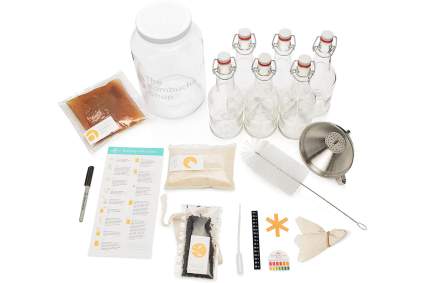
|
Amazon Customer Reviews
|
Price: $89.99 Shop at Amazon | Shop now Read our review |
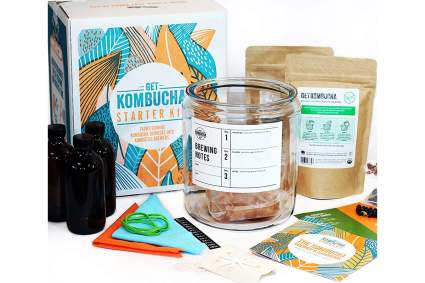
|
Amazon Customer Reviews
|
Price: $75.95 Shop at Amazon | Shop now Read our review |
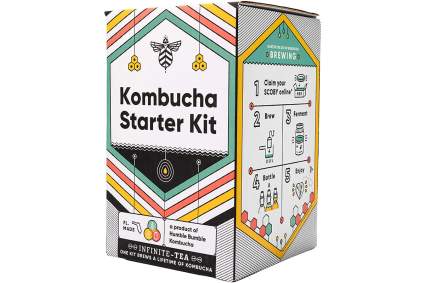
|
Amazon Customer Reviews
|
Price: $44.95 Shop at Amazon | Shop now Read our review |
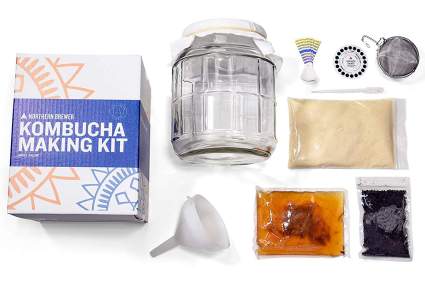
|
Amazon Customer Reviews
|
Price: $68.99 Shop at Amazon | Shop now Read our review |
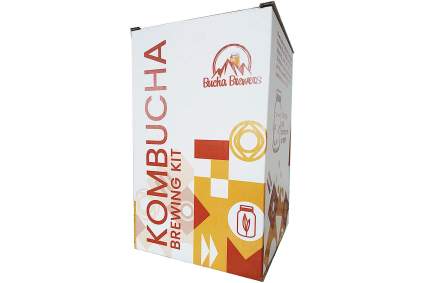
|
Amazon Customer Reviews
|
Price: $44.99 Shop at Amazon | Shop now Read our review |
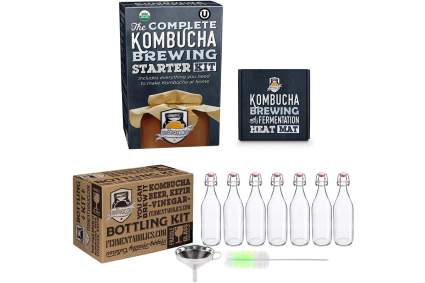
|
Amazon Customer Reviews
|
Price: $92.99 Shop at Amazon | Shop now Read our review |
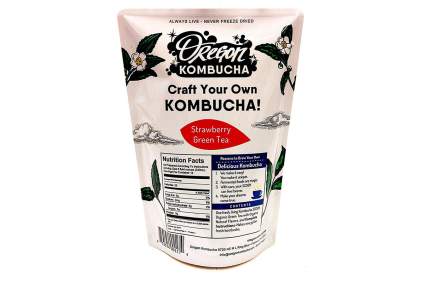
|
Amazon Customer Reviews
|
Price: $22.53 Shop at Amazon | Shop now Read our review |
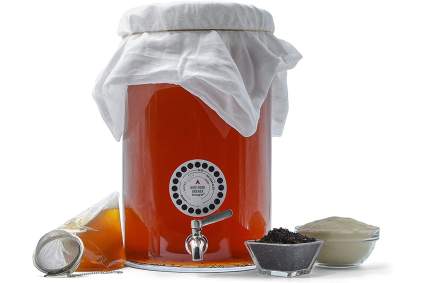
|
Amazon Customer Reviews
|
Price: $110.99 Shop at Amazon | Shop now Read our review |
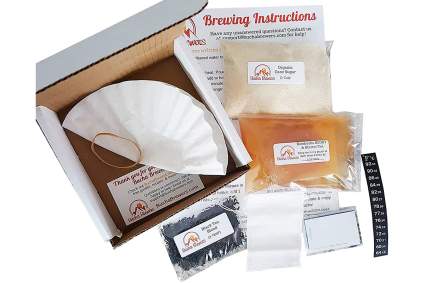
|
Amazon Customer Reviews
|
Price: $29.99 Shop at Amazon | Shop now Read our review |
-
1. EDITOR’S CHOICE: The Kombucha Shop Deluxe Kit
Pros:- My top pick
- Everything you need and more
- Fantastic instructions
- Includes brewing vessel and six glass bottles
- Organic loose leaf black tea and organic cane sugar
- pH test strips, guide, and thermometer sticker
- Bottle brush, funnel, and strainer for bottling
- Brewing jar as space for notes (marker included)
Cons:- Pricier than some
- Not everyone loves the tea blend
- Might not need all the extras
If you truly want to get everything you need in one stop, then you want the Deluxe Kit from The Kombucha Shop. It includes everything you need to brew as well as bottle your kombucha.
It’s a little pricier than some of the other kits, but you don’t see many kits that include both a glass brewing vessel as well as six glass swing-top bottles for your second fermentation which is where you get all those lovely bubbles and when you can flavor your kombucha.
The glass one-gallon jar comes with a cloth cover, rubber band, and has a section printed on it for brewing notes, date, and type of tea. They even include a dry erase marker for writing in your notes.
For the actual brewing, you get a blend of organic loose-leaf black tea, organic cane sugar, scoby with starter tea, pH strips for testing, pipet for sampling, and a thermometer sticker for the outside of your brewing vessel to monitor how warm your batch is.
Once your kombucha is done, this set goes the extra mile and includes supplies for bottling your finished kombucha so it can carbonate, be flavored, and easily stored in your fridge. They provide a strainer and funnel to use with the six swing-top glass bottles. They even include a bottle brush for cleaning the bottles between uses which is a must because the yeast can really stick to the bottom and sides of bottles.
If you don’t want the bottling supplies, you can also buy their classic kit which sticks to the core brewer supplies.
The instruction sheet is highly detailed and easy to follow, making it worth a huge chunk of this price tag alone.
Find more The Kombucha Shop Deluxe Kit information and reviews here.
-
2. Get Kombucha Starter Set
Pros:- 6.5-inch scoby
- Enough ingredients to brew more than one batch
- Reusable steeping bags
- Includes covers and rubber bands
- Organic tea blend and cane sugar
- Four botanical blends for flavoring
- Comes with pH test strips
- One-gallon jar with note section
- Includes bottling supplies
Cons:- Jar looks too wide for coffee filters
- Test strips won't last long
- No spigot or siphon
For those who love flavored kombucha with enough ingredients to last them a few brewing cycles, check out Get Kombucha.
It comes with a wide-mouth glass brewing vessel with area for printed on it to take notes on your brewing like flavors and dates. The set comes with one pound of organic cane sugar and has enough organic tea for 60 servings.
Another huge draw to Get Kombucha is their large 6.5-inch diameter scoby which is much bigger than most scobys that you’ll find in starter sets. A nice thick scoby with plenty of starter like this is more resilient jostling and changes in temperature during shipping.
The kit also comes with five pH test strips, two reusable muslin steeping bags for tea, two cloth covers, two extra-large rubber bands, one pair of gloves, instruction booklet, bottling funnel, three amber bottles, and a set of four different botanical flavoring blends: juniper berry and cardamon, hibiscus and ginger, rosebuds, and cinnamon and elderberry. I like that they’ve included these fun flavoring options as something for brewers to play with.
Find more Get Kombucha Starter Set information and reviews here.
-
3. Craft A Brew Kombucha Starter Kit
Pros:- Made in America
- Safe glass one-gallon jar
- Includes tea and sugar
- Scoby is shipped when requested to keep it fresh
- Includes cover
- Bee logo makes for stylish brewing jar
Cons:- Doesn't include supplies for bottling
- Have to wait for separate scoby shipment
- Instructions could be better
- No tap or syphon
This simple and affordable Kombucha Starter Kit from Craft A Brew includes the tools and ingredients you need to brew one gallon of kombucha at a time.
It comes with a one-gallon glass jar which is the safest material for brewing your kombucha. It’s also nice because you can easily see what is going on in there. The jar has the Humble Bumble Kombucha logo on it which spruces up the jar with a trendy bee image. You also get a Humble Bumble cloth cover for the jar and elastic band.
For brewing, you get loose leaf organic black tea, organic cane sugar, and a claim code for a packet including a scoby and around one cup of starter tea. (Depending on timing, you scoby will either be sent with your kit to you or you’ll get a claim code so you can get one sent out fresh. An instruction booklet guides you through the process of brewing.
One gallon is a good size and is what I’m working with at my house. It makes about four bottles of kombucha at a time if you save around two cups for your next batch. Just be sure to save some of the tea and your scoby when your first batch is done so you can use it to brew your next batch.
The biggest downside here is that there isn’t a spigot on the jar so emptying it once your kombucha is done is not impossible but not as effortless.
Find more Craft A Brew Kombucha Starter Kit information and reviews here.
-
4. Northern Brewer Kombucha Making Kit
Pros:- Enough tea and sugar for two batches
- Unique barrel shaped glass brewing vessel
- Reuseable tea ball
- Thermometer sticker and pH test strips
- Cloth cover and rubber band
Cons:- Wide jar may not work with coffee filter lids
- No bottles
- Non-standard 1.75-gallon jar
If big glass jars are too boring for you, check out this barrel-shaped jar in the Northern Brewer’s Kit which brings in thoughts of wine or whiskey casks. The vessel is larger than most on here with a capacity of 1.75 gallons.
It comes with everything you need including enough tea and cane sugar for two one-gallon batches, scoby with starter tea, reusable tea brewing ball, cloth cover, rubber band, pH test strips, round thermometer sticker, pipet, and funnel.
Find more Northern Brewer Kombucha Making Kit information and reviews here.
-
5. Bucha Brewers Starter Kit
Pros:- Everything you need
- Affordable
- More pH test strips than most kits
- Organic cane sugar and black tea blend
- Thermometer sticker
- Glass brewing vessel
- Coffee filters for cover
Cons:- Coffee filters aren't as attractive
- No bottling supplies
- No heating mat
For a kit on a budget that still has everything you need to get started, go with Bucha Brewers. You’re not paying for bells whistles you don’t need.
It comes with a scoby and starter tea, glass brewing vessel, black tea blend, cane sugar, reusable tea bag, two coffee filter covers, rubber band, thermometer sticker, and a box of 80 pH test strips. You also get simple but clear instructions to get you started.
Most kits have some kind of cloth cover, but honestly, I prefer these coffee filter ones. They’re the perfect size and shape and have a tighter weave that lets air through but very little else.
I love that you get 80 pH test strips. Most kits only give you five single-use strips and let’s face it, when you’re brewing your first batch, you’re going to want to test it often to make sure it’s going okay and you’ll blow through five test strips in no time.
This is a good, simple kit to get you started with the basics.
Find more Bucha Brewers Starter Kit information and reviews here.
-
6. Fermentaholics Pro Kombucha Brewing Kit
Pros:- Three kits to choose from
- Pro has everything plus bottling supplies
- Includes kombucha heating mat
- One-gallon glass vessel with area for brewing notes
- Thermometer sticker and pH testing strips
- Cover and rubber band
- Seven swing top bottles
- Funnel
- Bottle cleaning brush
- Flavoring guide
Cons:- Some kits have more tools than you may want
- Only enough tea and sugar for one batch
- No filter on the funnel
Fermentaholics has three levels of kombucha brewing kits so you can choose the number of extras you need.
If all you want is the basics, their Organic Complete set includes a glass brewing vessel, cover, rubber band, organic cane sugar, organic tea blend, scoby and starter tea, pH test strips, thermometer sticker, and a flavoring guide.
Once your kombucha is ready, you’ll need to bottle it and if you want that fizzy, effervescent kick that you get from store-bought ‘booch, you’ll need bottles that were designed to allow for natural carbonation. The Deluxe Kit comes with everything in the basics set as well as seven swing-top bottles, a funnel, and a bottle brush for easy cleaning.
I’m highlighting their Pro Kombucha Brewing Kit which is perfect if you live in a colder climate like I do. It has everything from the Deluxe kit including bottling supplies and adds in a kombucha heating mat. In order to properly ferment, your brew has to be at a fairly warm temperature, which means up north it’s hard to keep your brew going in the winter. This mat hugs the brewing vessel like a belt and keeps your kombucha at the proper temperature.
Find more Fermentaholics Pro Kombucha Brewing Kit information and reviews here.
-
7. Oregon Kombucha’s Flavored Kits (Scoby & Tea Only)
Pros:- Affordable
- Many yummy flavors
- No extras you don't need
- You can choose your own jar
Cons:- You need your own vessel, sugar, etc.
- Flavors really only last one batch
- Flavored tea isn't best for brewing
- No bottling supplies
This Craft Your Own Kombucha kit is about as pared down as it gets and provides the scoby with starter and flavored black tea.
This is great if you already have your own supplies or would rather pick out your own vessel and sugar. You bring your own jar, coffee filter or cloth cover, rubber band, and sugar (plain white sugar is perfectly fine).
There are interesting tea flavors that lead to flavored kombucha like Strawberry Green Tea, Pear Ginger Black Tea, Coconut Green Tea, and Blueberry Black Tea.
If you don’t have your own jar, you can pick up a glass brewing vessel with a spigot, stand, and chalkboard sign for relatively cheap.
Find more Oregon Kombucha's Flavored Kits (Scoby & Tea Only) information and reviews here.
-
8. 3-Gallon Northern Brewer Starter Kit
Pros:- Large three-gallon vessel
- Includes thermometer and pH strips
- Spigot for easy sampling and bottling
- Everything you need
- Adhesive thermometer and pH test strips
- Reuseable tea ball
Cons:- Too big for some
- No bottling supplies
- Not everyone likes spigot designs
- Scoby looks small
For those who are looking to produce a lot of kombucha, Northern Brewer has a three-gallon starting kit.
It’s big enough for large batches and the spigot is great for bottling, sampling, and to use as a continuous brewing system. Continuous brewing is when you draw a portion of the kombucha off instead of bottling the entire batch and add a similar amount of sweet tea back into the vessel. That way you don’t need to empty the whole jar and you always have kombucha on tap.
The rest of the kit has all the standard parts you expect from a quality kit including organic cane sugar, black tea, reusable tea ball, adhesive thermometer, pipet, pH test strips, scoby with starter, cloth cover, and a rubber band.
Find more 3-Gallon Northern Brewer Starter Kit information and reviews here.
-
9. Bucha Brewers Scoby Set (No Jar)
Pros:- Everything but the jar
- Affordable
- Includes tea and organic cane sugar
- Thermometer and 80 pH test strips
- Cover with rubber band
- Reuseable cloth tea bag
Cons:- No jar
- No bottling supplies
- Only enough sugar and tea for one batch
This set from Bucha Brewers comes with everything you need except for the jar. If you have your own glass one-gallon jar you can save a decent amount of money by going with this set.
It comes with a scoby and starter tea, loose black tea, organic cane sugar, two coffee filter covers, rubber band, 80 pH test strips, adhesive thermometer, and comprehensive instructions.
Find more Bucha Brewers Scoby Set (No Jar) information and reviews here.
What is Kombucha?
Kombucha is a fermented, carbonated drink brewed from black or green tea. While it's exact origins are fuzzy, most believe that dates back to around 200 B.C.E. from the Manchurian area of China.
It truly has a taste that is all its own, at once acidic and sweet. The best way I can describe it is kind of a funky champagne. You either (really) love it or hate it.
But while it is fizzy like champagne, kombucha actually has way more in common with sourdough bread.
What Is a Kombucha Scoby?
Beer and wine are fermented with yeast. Kimchi is fermented with specific bacteria. Kombucha is fermented with a combination of both, like a sourdough.
A scoby is really a S.C.O.B.Y which stands for "symbiotic colony (or culture) of bacteria and yeast." The yeast and bacteria colony grow together forming a mat of cellulose that often floats on top of the kombucha.
If you've ever accidentally let your balsamic vinegar get too warm and it grew a gelatinous "vinegar mother," kombucha is a very similar process.
Fair warning--scobys look like something only a mother could love. I've called them fleshy alien pancakes and that feels pretty accurate. They're rubbery, a little slimy, and can have long jellyfish-like tendrils hanging from the bottom. That said, I love each one of my scobys. They're like a really unattractive pet.
Plus there are loads of fun punny names to name your new scoby pal. Mine is named Scoby Dick but I've also seen Scoby Doo and Scoby Wan Kenobi.
Scobys are sometimes called kombucha mushrooms but they aren't a mushroom or fungus at all.
Kombucha is similar to the process of making sourdough bread. For the bread, you need a starter which is dough inoculated with a combination of yeast and bacteria. You keep that starter (your new weird gooey pet) fed and it can make an unlimited amount of bread.
Kombucha is made the same way--starter kombucha with a scoby is added to sweet tea and once the kombucha is ready, some saved starter tea and the scoby can be added to fresh tea to start the process all over again.
Can I Make Kombucha Starter Culture From Scratch Like a Sourdough Starter?
Here's where it differs. You can make your own sourdough starter by leaving a dough mixture out in the air to become a home for wild yeast and bacteria. Kombucha, not so much.
You really need kombucha to make more kombucha. You can attempt to grow your own scoby by letting store-bought kombucha sit at room temperature but these drinks are often pasteurized, flavored, or refrigerated which can greatly affect the strength resulting culture resulting in an unsafe brew.
Another thing kombucha and sourdough have in common is that different culture strains will result in different flavors and qualities. Different kombucha strains grown on different teas will have different types of bacteria and yeast in their colony. And like some bakeries, some brewers can trace the same culture back decades.
Is Kombucha Alcoholic?
Because it's a fermented beverage, kombucha does have a small amount of alcohol. To be sold in stores as a non-alcoholic drink, kombucha must contain less than 0.5 percent alcohol. Beer typically has around five percent alcohol in comparison.
So while kombucha is legally not alcoholic, it does contain some alcohol. Folks who are avoiding alcohol for health, addiction, or religious reasons, may want to skip kombucha.
In the same way, kombucha contains a small amount of caffeine. It's made with caffeinated tea and while the fermentation process "eats" over a third of the original caffeine, the resulting drink isn't entirely caffeine-free so if you have health or religious reasons to avoid caffeine, keep that in mind.
Is Kombucha Good for You?
You can find thousands of websites and posts talking about the endless health benefits of drinking kombucha from reducing inflammation to mental health improvements to lowing blood pressure.
According to Mayo Clinic, there is no science that backs up these claims. I drink kombucha because I enjoy it--not because I think it will prevent cancer.
One undeniable fact is that homebrew kombucha is packed with live bacteria, often the types you'd find in probiotic supplements. But again, there are no studies to back up the benefits to kombucha's probiotics.
Why Make Your Own Kombucha?
I make my own kombucha because I enjoy brewing, the same reason I brew my own hard cider and why I'm experimenting with making my own tempeh.
But the main reason most folks brew their own kombucha is that store-bought is so expensive. A one to two serving-sized bottle at the store is easily $4 or more while you can make that same amount for under $1 at home.
How to make kombucha.
There are loads of sites that are focused solely on this process but I'll give you a rundown of my experience brewing kombucha.
Gather supplies.
You'll need a scoby, one to two cups of concentrated starter tea from your kit or previous batch, black or green tea bags, white sugar, clean brewing container (glass is best), distilled white vinegar for cleaning, and a cover to keep out bugs but let the brew breathe--I use a paper coffee filter held on with a rubber band.
Brew the sweet tea.
Proportions depend on how much you're brewer holds but you'll want to bring water to a boil and turn off the heat. There's some discussion on adding the tea or sugar first but I haven't found it makes a huge difference. I add my white sugar and stir until it dissolved. (Don't substitute with honey as it's anti-microbial.) Then I add my tea bags and let steep for five minutes.
While tea comes to room temperature, set up your brewer.
Rinse your container and hands with white vinegar. Don't use antibacterial soap as it can kill the bacterial you're trying to grow.
Add your cooled sweet tea to the brewer and then add your one to two cups of starter tea. Mix with a clean (non-wooden) spoon. This starter is necessary to lower the pH of the tea to prevent bad bacteria or mold from growing on the scoby.
Gently add your scoby. If it doesn't float on top, don't panic. A scoby that has sunk will still work and you'll find you have a new baby scoby growing on top after a few days.
Cover your brewer with a breathable cloth or coffee filter that will keep out fruit flies.
Monitor and wait.
Depending on the temperature of your home, your kombucha can take days or weeks to be ready. The warmer the temperature, the faster it will brew. As it ferments, your very sweet tea mixture will become less sweet more and more acidic. You can monitor it with regular pH level checks or, as I do, simply taste it every few days and pull it when it reaches your preferred level of sweetness.
You'll also need to monitor your scoby for signs that your tea has attracted unwelcome guests like fruit fly eggs, mold, or a bad nail polish remover smell that could mean you have unwelcome bacteria. If you find these, you'll need to throw out the whole batch and start over.
Bottle and flavor your kombucha.
Now that your first fermentation is done, you can either drink it as is or you can seal it in bottles and wait a few more days so it can become carbonated. I use swing-top bottles for my second fermentation.
This is also when you would add any extra flavorings. My go-to is fresh ginger juice, frozen cherries, and a pinch of sugar to give the kombucha a little boost for extra bubbles.
No homebrew or fermentation is foolproof.
Keep in mind that any time you're playing with brewing or fermenting at home that there's always an element of personal risk. There's a chance you might grow some nasty microbes by accident that could make you sick.
Make sure you're being very careful to clean all your supplies and to use the correct type of brewing vessel. Avoid pottery as the acid in kombucha can leach lead from the ceramic into your drink which is really not good at all.
Follow the directions in your kit, do extra research on your own, and get involved in the kombucha community who will be happy to answer questions and look at photos of your scoby to tell you if it's looking normal.
It also doesn't hurt to check in with your doctor. People who are pregnant or significantly immunocompromised may want to avoid the unnecessary risk of brewing their own kombucha at home.
Kombucha brewing tips.
Keep your vessel out of direct sunlight.
Distilled white vinegar is your best friend. Rinse everything in it before touching your scoby.
If your scoby is too wide for the mouth of the jar, don't be afraid to bend or fold it.
You can protect your culture by placing part of your brew and a piece of scoby in a small jar to set off to the side in a dark place. This is called a scoby hotel and is great in case your main culture gets mold or fruit flies so you have a scoby to fall back on and don't have to start from scratch.